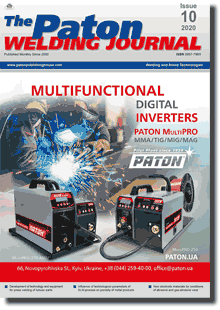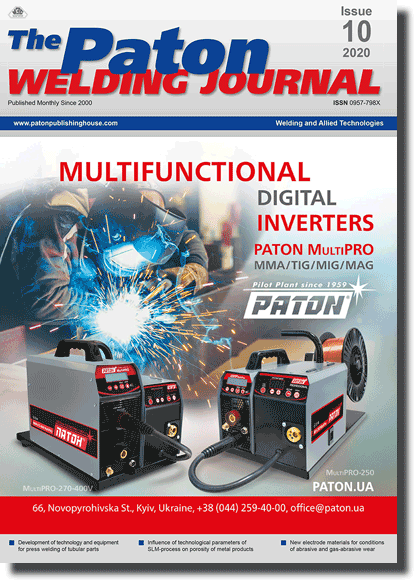| 2020 №10 (06) |
DOI of Article 10.37434/tpwj2020.10.07 |
2020 №10 (08) |

The Paton Welding Journal, 2020, #10, 35-39 pages
Influence of antimony on structure and mechanical properties of pre-eutectic copper-phosphorus alloys
S.V. Maksymova, A.N. Pisarev, P.V. Kovalchuk and V.V. Voronov
E.O. Paton Electric Welding Institute of the NAS of Ukraine 11 Kazymyr Malevych Str., 03150, Kyiv, Ukraine. E-mail: office@paton.kiev.ua
Abstract
The results of investigations of pre-eutectic alloys of Cu–P–Sb system are presented. The melting temperature range was determined using high-temperature differential thermal analysis. It was found that antimony alloying of copper-phosphorus pre-eutectic alloy provides a decrease in the solidus and liquidus temperature. On the basis of experimental and literature data, the surfaces of liquidus and solidus of ternary alloys were constructed. Using micro-X-ray spectral analysis, the chemical composition and a number of structural components of Cu–6.29P–1.97Sb alloy were determined. The influence of antimony on technological and mechanical properties, as well as morphology of cast ternary pre-eutectic copper-phosphorus alloys is shown. 10 Ref., 2 Tables, 6 Figures.
Keywords: copper-phosphorus pre-eutectic alloys, antimony, temperature of solidus and liquidus, microstructure, ultimate tensile strength
Received 30.09.2020
References
1. Petrunin, I.E. (2003) Handbook on brazing. Моscow, Маshinostroenie [in Russian].2. Pashkov, I.N., Ilina, I.I., Shapiro, A.E. (2006) Properties and applications of Cu-based silver free brazing filler metals made by rapid solidification technique. In: Proc. of the 3rd Int. Brazing and Soldering Conf. (San Antonio, Texas, USA), 157–166.
3. Pashkov, I., Pashkov, A. (2012) Change in phase morphology and composition during the spreading of liquid alloy, which is actively interacting with base metal surface. In: Proc. of the 5th Int. Brazing and Soldering Conf. (Las Vegas, Nevada, USA), 240–243.
4. Boutilier, J., Brown, N., Klidas, N., Alexandrov, B.T., Shapiro, A.E. (2018) Strength of steel, copper, and brass lap joints brazed by silver-based and silver-free filler metals. In: Proc. of the 7th Int. Brazing and Soldering Conf. (New Orleans, USA), 360–366.
5. Drits, М.Е. (1979) Binary and multicomponent systems based on copper (Reference). Moscow, Nauka [in Russian].
6. Vozdvizhensky, V.N., Grachev, V.A., Spassky, V.V. (1984) Casting alloys and their melting technology in mechanical engineering. Moscow, Маshinostroenie [in Russian].
7. Lyakishev, N.P. (1999) Constitutional diagrams of binary metal systems. In: Refer. Book: 3 Vol., Vol. 3. Book. 1. Moscow, Маshinostroenie [in Russian].
8. Smiryagin, A.P., Smiryagina, N.A., Belova, A.V. (1974) Industrial nonferrous metals and alloys. Moscow, Metallurgiya [in Russian].
9. Suchkov, D.I. (1967) Copper and its alloys. Moscow, Metallurgiya [in Russian].
10. Pisarev, A.N., Doroshenko, L.K., Safronova, E.A. (1992) Copper fusibility angle of the copper-phosphorus-antimony system. In: Physical chemistry and technology of phosphides of phosphorus-containing alloys. In: 2 Parts. Pt 2. Alma-Ata, Gylym, 18–22 [in Russian].
Suggested Citation
S.V. Maksymova, A.N. Pisarev, P.V. Kovalchuk and V.V. Voronov (2020) Influence of antimony on structure and mechanical properties of pre-eutectic copper-phosphorus alloys. The Paton Welding J., 10, 35-39.The cost of subscription/purchase order journals or individual articles
| Journal/Currency | Annual Set | 1 issue printed |
1 issue |
one article |
| TPWJ/USD | 384 $ | 32 $ | 26 $ | 13 $ |
| TPWJ/EUR | 348 € | 29 € | 24 € | 12 € |
| TPWJ/UAH | 7200 UAH | 600 UAH | 600 UAH | 280 UAH |
| AS/UAH | 1800 UAH | 300 UAH | 300 UAH | 150 UAH |
| AS/USD | 192 $ | 32 $ | 26 $ | 13 $ |
| AS/EUR | 180 € | 30 € | 25 € | 12 € |
| SEM/UAH | 1200 UAH | 300 UAH | 300 UAH | 150 UAH |
| SEM/USD | 128 $ | 32 $ | 26 $ | 13 $ |
| SEM/EUR | 120 € | 30 € | 25 € | 12 € |
| TDNK/UAH | 1200 UAH | 300 UAH | 300 UAH | 150 UAH |
| TDNK/USD | 128 $ | 32 $ | 26 $ | 13 $ |
| TDNK/EUR | 120 € | 30 € | 25 € | 15 € |
AS = «Automatic Welding» - 6 issues per year;
TPWJ = «PATON WELDING JOURNAL» - 12 issues per year;
SEM = «Electrometallurgy Today» - 4 issues per year;
TDNK = «Technical Diagnostics and Non-Destructive Testing» - 4 issues per year.


